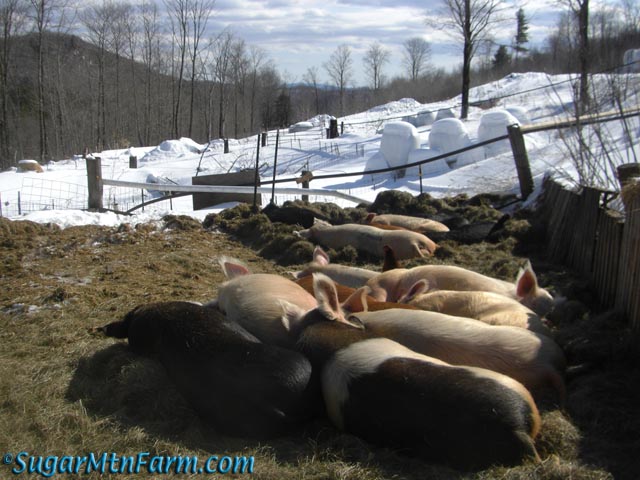
Sows in Winter Garden
During the warm months our pigs graze on about 40 acres of pasture using managed rotational grazing techniques that we originally learned with our sheep. This produces most of their food from the land, distributes manure and urine naturally where the plants need it, improves soil health and stimulates forage growth.
In the winter the animals pull inward on our farm to about ten acres of winter paddocks. These are much like deer yards out in the forest. By keeping the snow packed in a wind sheltered area in a tighter group the animals fare better through the cold season. We give the animals hay which is pasture stored in bales for winter just like we can and dry veggies for our own family table.
Early on I figured out that genetics make a huge difference in winterability of the pigs. Some have the ability to tolerate, even thrive, in our cold northern Vermont mountain winters. Other’s don’t. This is not random. It was also not a matter of breed but rather genetic lines within the breeds. We have Yorkshire, Berkshire, Large Black, Tamworth as well as crosses of these which are our Mainline, Blackieline and Redline. There is a little Glouster Old Spot mixed in with our mainline as well. Within the lines I could clearly distinguish genetics for winterability. We’ve been selecting hard for these characteristics so now our pigs are hearty and in great condition through the winters on a diet that is primarily hay with the addition of some whey, apples, etc. (See this post for more about our pigs’s diet and follow the feeding links for details.)
How the individual pigs themselves fare through the winter is not the only important wintering characteristic. The sows must also be able to farrow in our cold climate. With confinement operations they have bred out good mothering by using farrowing crates for birthing. If you just take confinement genetics and dump that sow on pasture to farrow naturally she may do poorly because she doesn’t have the right instincts to build a nest and farrow without assistance. Even harder is that a sow who may farrow fine in the warm months on pasture may not farrow well in the winter months. Farrowing is a set of genetic traits that I can trace through our lines. Over the past twelve years I’ve been working to choose those who farrow best through the entire year, both cold season and warm, to produce each subsequent generation of replacement gilts. Only about 5% of gilts ever get to test as breeders and how their mothers performed is one of the scores they get. This hard culling pays off in improvements in the sow’s farrowing ability without the need for any crates or heated buildings.
Conventional agricultural wisdom is that animals must be closed in, especially during the winter but that is a bad idea. Just like a too tight house is bad for people, confinement is bad for the animals because it produces ill health, respiratory disease and greasy pig as is common in confinement operations. The animals need sunlight, fresh air and the ability to move around. CAFOs use antibiotics and such to fight the problems confinement produces.
We have a different strategy, using open wintering sheds and the best ones are open greenhouses. These have bright sunlight that naturally kills bacteria, plenty of fresh air and warm deep bedding packs. The open structures are at most three sides and a roof with a cross flow vent to allow for good healthy air flow.
Good genetics means better wintering and better litters without having to close the animals in or use medicated feeds. It is a more natural healthier system that works and is good for us as well.
Outdoors: -22°F/4°F Sunny
Tiny Cottage: 64°F/58°F
Daily Spark: I know the price of success: dedication, hard work and an unremitting devotion to the things you want to see happen. -Frank Lloyd Wright





